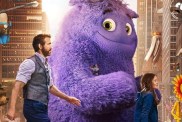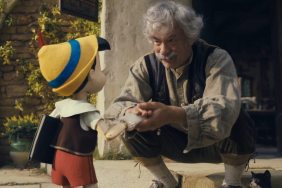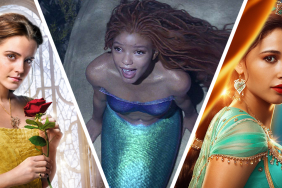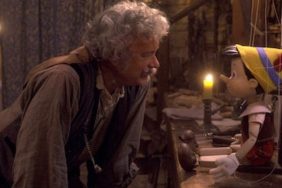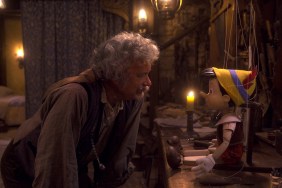
Lee Gambins Secretly Scary column continues to look at non-horror films that are secretly horror films!
In Disneys PINOCCHIO, an absolute masterpiece of animation and storytelling, one of the most profound central themes that sits as the thematic crux is the complicated notion of doing the right thing and always letting your conscience be your guide. However, those ideals are something that must be sought after and earned for our innocent and gullible puppet protagonist who eventually learns to be virtuous, brave and righteous which in turn, earns him the right and gift of becoming a real life little boy. The naive Pinocchio goes through the film being seduced by rather malevolent forces, namely represented by the motion pictures multiple villains and sinister situations that are presented to the guileless hero, and one of the films masterful highlights is Pinocchios seduction into Pleasure Island, a place populated by viscously rambunctious little boys. However, the naughty boys in the film are presented as voiceless and faceless (they are seen in the distance and in sequences where they are bundled together, giving them no humanity at all) and they are also set up to be victimized as they are eventually turned into donkeys to plough through salt mines for one of the movies central bad guys, The Coachman.
PINOCCHIO really boasts a cavalcade of villains from the get go the lascivious fox Honest John and his mute violent simpleton companion the cat Gideon, the rough and aggressively greedy Stromboli, the aforementioned sinister sleaze merchant of The Coachman, the snickering, jaded Lampwick who transforms into a jackass right in front of our innocent little Pinocchios eyes and then finally Monstro, a huge blue whale of biblical proportions. Disney never shied away from presenting darkness and the realm of the malevolent and sinister, after all, most of the source material these magnificent films came from were written with horror fundamentally embedded within the make-up of the piece in order to teach, guide, enlighten and hold a moral code for the young reader/listener to go by. When Pinocchio lands on Pleasure Island, this sentiment is most definitely jolted into activity as the threat of indecency, moral corruption, misbehavior and unruliness are used as an extension of evil and the dark recesses of the not-so-human heart. Pleasure Island is a place for misfit boys who are free to do all the things that are deemed evil or corrupt such as smoking, drinking, playing pool, destroying perfect homes, desecrating art such as The Mona Lisa et al. Pinocchio is thrust into this world and he becomes what Jiminy Cricket (his conscious personified) fears most a troubled child-to-be.

Pinocchios friend on Pleasure Island is the aforementioned Lampwick, one of the boys who seems completely at home in this parentless dystopia. When Jiminy tries to defend innocent Pinocchio from Lampwick, the naive puppet cries: Oh dont hurt him Jiminy, hes my best friend! This agitates Jiminy as he knows that Lampwick is far from being a best friend. He is a bad influence, a nasty crass kid who is old before his time. The artistic design for Lampwick by Disney artist Fred Moore is extremely careful and intelligently conceived. He looks like a grown man in a childs body and his transformation from impish kid to terrified donkey is completely frightening and is easily comparable to any werewolf transformation sequence in any lycanthropic themed film. Director Joe Dante quotes the sequence as being influential as well as genuinely frightening in this regard, and the image of hands turning into hooves and a face stretching out into the snout of a donkey in silhouette form can completely be attributed to his design and look for the Eddie Quist transformation in his iconic The Howling (1981). Lampwick gives a face to the unseen victimized evil little boys that populate Pinocchio, and he is presented as a foul no-good kid whose fate is accepted by the audience as he comes to represent the worst of childhood the disobedient, the vile and the cynical. When he turns into a donkey it makes sense, there is no pathos, however for the terrified Pinocchio – who does develop the ears and tail of a mule because he was seduced and ran off the straight and narrow there is hope and the hopeful audience wants to see the misguided puppet become a real life boy. Of course, this happens, and this only happens after a literal Jonah and the whale scenario pans out, during the rescue of his earthly father Gepetto and his true friends Cleo the goldfish, Figaro the cat and of course Jiminy Cricket. Aided by the Blue Fairy who grants him this wish, Pinocchio manages to escape the malevolence that is peppered throughout the Italian landscape that frames the film. Evil is ever present in this Disney outing, and it collects the innocent and manipulates them. The attention bought to temptation in Pinocchio is what fuels the impending and creeping menace, while the loose and free-falling dropping in and out of sin and leanings towards the ominous and baleful is what gives the film its sturdy and driving backbone. When Pinocchio earns his stripes and does good, God is in his heaven and all is right in the world, however, for the mean children who refuse to embody righteousness, a horrendous fate falls unto them where they are simply dispatched and transformed into dutiful enslaved donkeys.

Much like the Lost Boys in Disneys Peter Pan (1953), the children in PINOCCHIO dont have parental figures and therefore are easily led astray and/or become feral as seen more explicitly in The Lord of the Flies (1963) and later as eaters of the elders in Children of the Corn (1984) and Beware Children At Play (1989), the latter film (undervalued because of its poor production values) using “Beowolf” as an inspiration and enlisting Anglo Saxon ritualistic killings into its plot, with the high concept of Grendel and cannibalism thrown in the mix. The myth of Grendel will pop up in reference at the end of the very good Australian film Fortress (1985) where school teacher Rachel Ward recites the legend to her newly changed child-warriors. Pinocchio warns children that if they dont do the right thing, they will end up being exploited by menacing adults; adults without any real connection to humanity Stromboli is a character completely obsessed with money and making money and using show business as his means to obtain this blood money. The animalistic villains of the piece; Honest John, Gideon and Monstro are completely detached from goodness but being beasts themselves this is something easier to swallow.
Predatory sexual subtext makes itself known in the sequence where Pinocchio is seduced by coded queer villains Honest John and Gideon. These lascivious theatre lovers successfully lure the innocent Pinocchio and force him into show business. Honest John is a morally bankrupt fox who uses flowery words to manipulate Pinocchio as well as his sidekick Gideon. Gideon, the assigned bottom, is a mute cat and completely obsessed with Honest John. This kind of pairing will soon be seen throughout Disney features where domineering queer villains had sycophantic partners racing after them ready with a compliment and a friendly ear – Smee is smitten by Captain Hook in Peter Pan, Sir Hiss fusses over Prince John in Robin Hood (1973) and so forth.
Disney villains, when presented as simple humans without any supernatural powers such as sorcery (as seen in many of the witches that pose as threats to the likes of Snow White et al) are devoid of a spiritual center (Lady Tremaine in Cinderella (1950) is cold and unfeeling, Gaston is vain and abusive in Beauty and the Beast (1991) etc) and it is up to our heroines (and heroes like Pinocchio) to find their inner strength and fundamental power. It is also hard for these Disney characters to understand the benefits of nurturing environments and guidance as, unlike most horror movie children who usually lack the presence of a father, most of them are distinctively motherless which all the more makes Wendy Darling’s comforting words/song to the brash Lost Boys of wisdom about the importance of a mothers in Peter Pan.

Pinocchio is vividly painted, lush, rich in tone and story and in many ways is a response to the children of the Depression. It draws lovely parallels with Vincente Minnelli’s magnificent seasonal favorite musical (and one of the earliest of the mainstream integrated musicals) Meet Me In St. Louis (1944). Here, much like Pinocchio with his eagerness to please and connect, little Margaret O’Brien and the pint-sized residents of the featured halcyon town celebrate Halloween by terrorizing aging neighbors and starting a bonfire burning the wares of adults. When little Margaret O’Brien pleases the other children by desecrating houses and attacking an elderly school master, she is christened “The Most Horrible” and relishes in this. She screams it and shouts it and is so filled with glee that she is the most horrible. Pinocchio has this potential as well, however he is quickly taught that playing with fire is dangerous and deadly, so he retreats back to the safety of simple pleasures and the comfort of familial surroundings. Disneys Pinocchio is a testament to the ghostly evils of the human condition, the monstrous aspect of the natural and unnatural order and the righteous continually scrutinized, trivialized and jeopardized by the manner of malice, misguidance, violence and internalized dread and fear.


